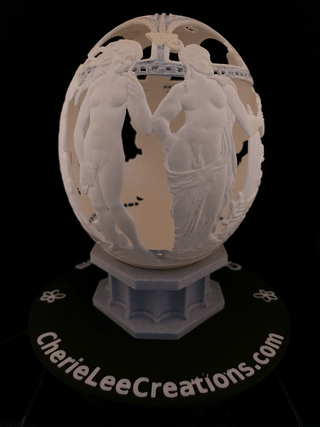" ‘A Study on the Enantiomer of Classic Beauty’"



In this first full foray into the human form, " ‘A Study on the Enantiomer of Classic Beauty’" pushes shallow bas relief to nerve-wracking levels!
As our culture re-examines sexuality, this piece playfully asks us to modernize our antiquated perceptions of "classic" beauty. Things are not what they seem at first glance --- look closely, and you'll inevitably discover more.
Michelangelo's 'David' switches roles with Sandro Botticelli's 'Birth of Venus', whose contemplative gaze falls upon the good fortune bestowed by the 'Statue of Aphroditus' (Roman, Imperial). Aphroditus stands and assumes the title role of Michelangelo's 'Creation of Adam', and jauntily beckons the Creator, Titian's 'Venus with the Organ Player'. The Creator floats as if a dream above the 'Bronze Statue Of Eros Sleeping', who is the recipient of David's care-filled stare.
'The Three Graces', portrayed here by Bertel Thorvaldsen's 'Adonis', Praxiteles' statue of 'Hermes Carrying Infant Dionysus' (rear view), and The Farnese Hermes, revel in mute solidarity, as blind as Justice and deaf to persuasion.
All figures referenced are switch-gendered, and source images* are flipped, except for the 'Creation' vignette.

Shown in progress:






Playing with live-time projected images onto the carved eggshell surface:



* Source images referenced, for the truely nerdy: Michelangelo's 'David' – (1501/04 | 17'× 6.5' | marble): The statue soon came to symbolize the defense of civil liberties , a symbol of strength and youthful beauty (the figure has an unusually large head and hands (particularly apparent in the right hand). Botticelli's 'Birth of Venus' – (1485 ca. | 5'8"x 9'2" | tempera on canvas): Celebrates the goddess of love and beauty arriving (met by a young woman, who is sometimes identified as one of the Graces or as the Hora of spring), 'The Three Graces' - (Roman marble statue from the second century bc, 48 7/16" x 39 3/8"): Linked in a dance-like pose , Aglaia (Beauty), Euphrosyne (Mirth), and Thalia (Abundance) bestow what is most pleasurable and beneficent in nature and society: fertility and growth, beauty in the arts and harmonious reciprocity between men. Besides love and beauty, the girls were also associated with nature, creativity, fertility, charm, splendor, and joy, in other words, graces. Thorvaldsen's 'Adonis' – (1808/31 | life-sized | marble): Exhibiting the relaxed contrapposto position, the left hand resting on the hip, one of the few works in marble carved solely by Thorvaldsen's own hand, it is one of the works that is closest to the antique Greek ideals. Adonis, a youth of remarkable beauty, was a mortal lover of the goddess Aphrodite. The earliest known Greek reference to Adonis comes from a fragment of a poem by the Lesbian poet Sappho (c. 630 – c. 570 BC). He was described as androgynous for he acted like a man in his affections for Aphrodite but as a woman for Apollo. Thorvaldsen may have been schooled entirely at home. He never became good at writing, and he never acquired much of the knowledge of fine culture that was expected from an artist. He believed that only through the imitation of classical art pieces could one become a truly great artist. Praxiteles' 'Hermes' ( also known as the Hermes of Praxiteles or the Hermes of Olympia) - (330 BCE | 7'x3' | marble): Seen as the epitome of the ideal image of youthful gods in Greek art, the messenger of the gods was also a friend to mankind by relaying divine messages to mortals. Classical restraint and poise is replaced by an undulating body in a defined S-curve which defies equilibrium. Inclusion of babies/children in Late Classical sculpture is significant of social changes. Considered to be a “sensual” artist, Praxiteles is said to have represented with refinement the feminine body and the body of theephebe, the somewhat effeminate young man. Farnese Hermes – (1stC. | Roman | 6'6" | marble): Michelangelo's 'The Creation of Adam' – (1508–1512 | 9' 2" × 18' 8" | fresco): "Fair as the young men of the Elgin marbles, the Adam of the Sistine Chapel is unlike them in a total absence of that balance and completeness which express so well the sentiment of a self-contained, independent life..." — Walter Pater, The Renaissance: Studies in Art and Poetry, "The Poetry of Michelangelo" Titian's 'Venus with the Organ Player' (around 1550 | 210.0 x 115.0 cm | --------------------): Between 1516 and 1518 he created the most famous painting of his career, The Assumption of the Virgin. A shade of red has been named after him: Titian red. Statue of Aphroditus (Roman | Imperial | 2nd century AD | ------------------------): In Greek mythology Aphroditus was a male Aphrodite from Cyprus. A divinity, half male, half female, uniting in itself the active and passive functions of creation, a symbol of luxuriant growth and productivity. Bronze Statue Of Eros Sleeping (Unknown | 3rd–2nd century B.C. | Bronze Eros is a concept in ancient Greek philosophy referring to sensual or passionate love, from which the term erotic is derived. Eros has also been used in philosophy and psychology in a much wider sense, almost as an equivalent to "life energy". Eros was a god not simply of passion but also of fertility. His brother was Anteros, the god of mutual love, who was sometimes described as his opponent. The chief associates of Eros were Pothos and Himeros (Longing and Desire)